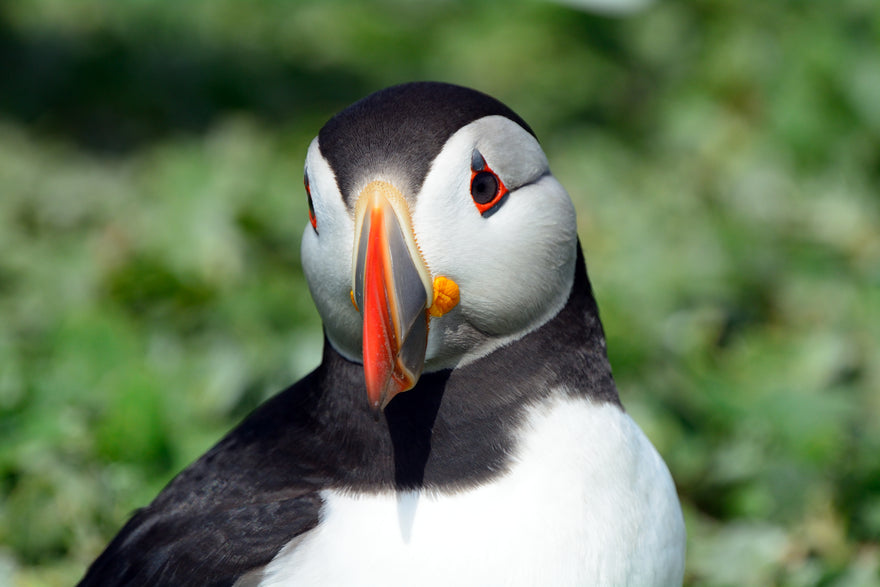July 17, 2018

A Circus of Puffins
Known in Orkney as the Tammie Norrie, the Atlantic Puffin is one of the world’s favourite sea birds. A member of the Auk family, there are approximately 580,000 breeding pairs in the UK.
Along with the Atlantic Puffin, are two other species of puffin, the Horned Puffin and the Tufted Puffin and these can be found on the Pacific coast of North America and Asia.
Sadly, over recent years, puffin numbers have plummeted across the UK and Europe, with the species being declared as “vulnerable” to extinction, with further declines expected between 50-79% by 2065. Puffins are also on the British Trust for Ornithology’s “Red List” for species of conservation concern in the UK. Reasons for the decline in numbers include overfishing, climate change, an increase in ground predators and marine pollution.
Striking Looks
The Atlantic puffin is surprisingly small, standing only at 7-8 inches tall, however, its majestic presence certainly captures the imagination. With striking black and brilliant white markings, along with a remarkable brightly patterned bill, they are instantly recognizable. They also have very colourful markings around their eyes, almost clown like, with bright orange legs and webbed feet. There are no major plumage differences between the male and female, although males are marginally bigger and heavier with a slightly larger bill. Puffins moult in late summer and during winter their plumage becomes less colourful, they also shed their vibrant bill plates which are then regrown in the spring.
Where to Find us
Puffins are in Orkney from March/April to until early August. Some of the best places to see puffins in Orkney are at the Castle of Burrian and Noup Head in Westray, Papa Westray, the RSPB reserve at the Old Man of Hoy, the Brough of Birsay, Yesnaby, Hoxa Head in South Ronaldsay and on the island of Copinsay. There are approximately 61,000 puffins in Orkney, with large numbers breeding on the remote Sule Skerry (40 miles west of the Orkney Mainland). Outside the breeding season puffins live out at sea.
Breeding
Puffins usually pair for life and remain together over the breeding period. However, it seems they don’t remain in pairs after they leave their breeding ground and return to sea for the winter. Puffins will nest in a burrow into the soil, under boulders, or in cavities in sea cliffs, and generally they will return to the same burrow each year. They only lay a single egg around late April/May each year, and both parents will incubate it for 36-45 days - sharing feeding duties until the chick, the “puffling”, is ready to fledge at around 38-44 days.
Food
Puffins feed on small fish such as sandeels, rockling (small members of the cod family), herring, sprat and even squid. Puffins are distinct in their ability to hold many small fish in their beak at a time due to the unique hinging mechanism of their beak, which allows the upper and lower biting edges to meet at a number of angles.

The Atlantic Puffin - Tammie Norrie
Project Puffin
During 2017, the RSPB, supported by the Heritage Lottery Fund Scotland, launched Project Puffin with the aim to help conserve puffins, by finding out what they feed their pufflings on, where they feed and how and why their numbers are changing.
The RSPB has gathered a wealth of information on the challenges puffins are currently facing. They carried out a census in Shetland undertaking puffin counts at key colonies. They also used GPS tracking tags to carefully track puffin movements and feeding habits in both the Shiant Isles in the Outer Hebrides and in Shetland.
From the study in Shetland, some puffins were travelling over 400km to find food, in fact the Shetland puffins were travelling much further than those from the Shiants in the west to find enough food to feed their pufflings. They also were taking back much smaller types of fish compared to those on the west.
Part of this remarkable project also included Puffarazzi where volunteers from all over the UK took photos of puffins with fish in their bills to find out more about their diets between different puffin colonies throughout the UK. One of the main threats to puffins is food supply, thought to be driven by global warming, causing rising sea temperatures and changes to the oceans current, which in turn has affected breeding in key colonies over recent years.
Hopefully studies such as these can help safeguard and improve conditions for these magnificent birds for generations ahead to enjoy.
Interesting Puffin Facts
Puffins have been found to have fluorescent beaks that glow under UV light
You can identify the age of a puffin from the number of grooves on the outer part of its bill
During the winter flight feathers are lost and birds are flightless for a time
A group of puffins is called a circus
The oldest puffin recorded was 40 years old - normal life span is approximately 20 years
Puffins can dive as deep as 60m under water
Puffins can beat their wings rapidly up to 400 times per minute
The Orkney Puffin Collection
Our majestic Orkney puffin stands proudly amongst the pink and lilac hues of sea thrift. To see more of this charming collection please visit https://bit.ly/2HMG4w6.
Puffin Tea Cup & Saucer
Puffin Sugar Pot & Creamer
Puffin Barrel Mug & Teapot
Puffin Cushion
April 23, 2018
Sign up to get the latest on sales, new releases and more …
